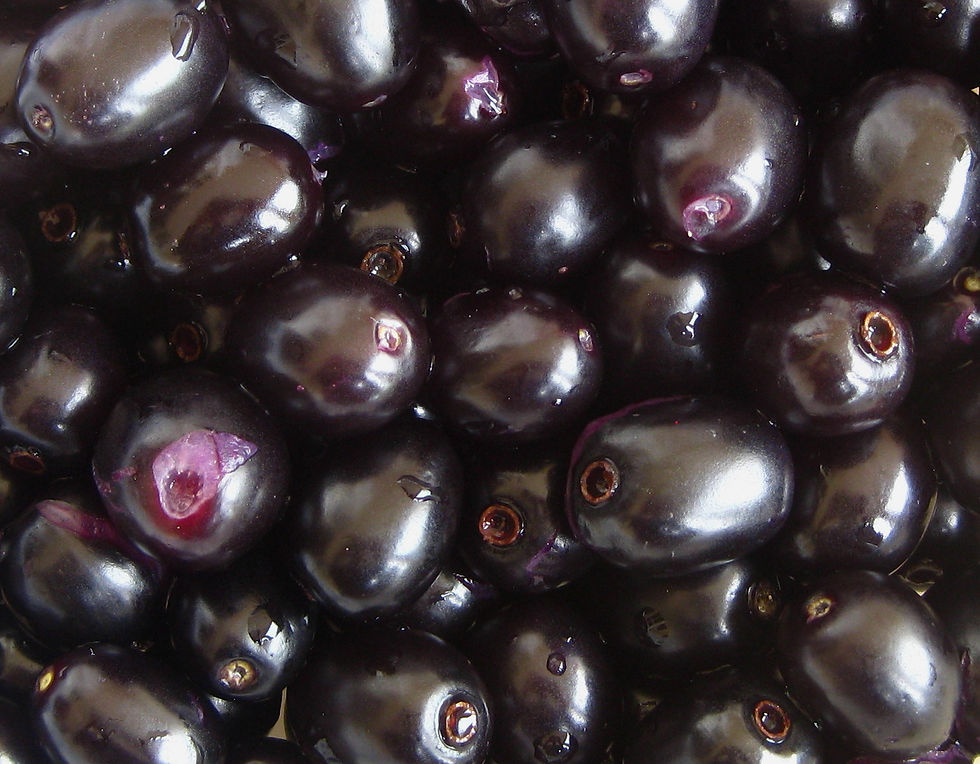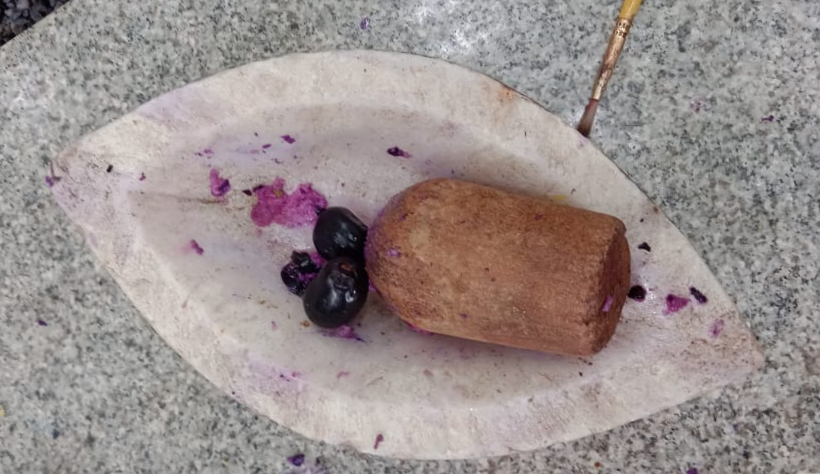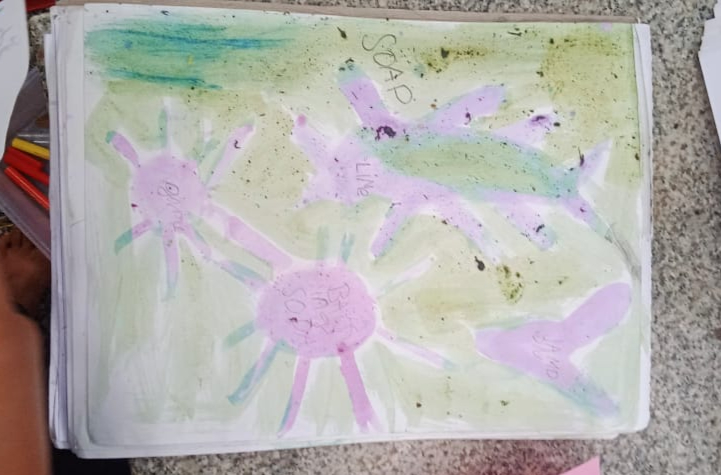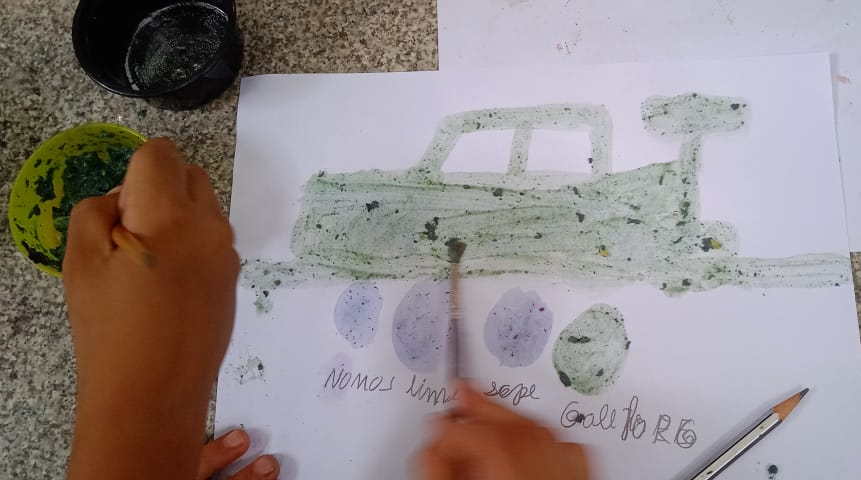Into the Jamunverse
- Chetana B P

- Oct 1
- 5 min read
Updated: Oct 6
Every time my mother visits us from the other side of the city, she brings at least four bags of goodies - one in each hand, one strapped to her back, and another that we help her carry up to our house. These bags are filled with our favourite dishes, homemade chutney pudis, homegrown coconuts and vegetables, plant cuttings from her garden, and whatever seasonal fruits she can get her hands on.
During her stay with us, John cooks his signature dishes, we go on long walks around our neighborhood, and we give her any plant cuttings from our garden that she desires - along with the dried banana peels and powdered eggshells we’ve collected for her garden.
When she visited in June this year, she brought us mango menaskai (a sweet curry), fried seppankilangu (colocasia), and dry fruit laddoos. She also carried a large box with more than a kilo of jamuns she got from my aunt’s tree! I was thrilled.

Preservation and Sweet Experiments
Jamuns (also known as Java plums or Syzygium cumini) are gorgeous, tart fruits that are highly seasonal and expensive, making them a precious resource. And these were freshly picked from a homegrown tree!
A kilo of jamuns was still a lot for just the two of us, and I was worried they might get moldy if we didn’t finish them quickly.
“Make jamun jam!” said my mother.
I had never tried it before, but I was keen to give it a go. A jam would be a marvellous way to preserve and savour the rich goodness of jamuns for a few months longer in the year.
Making jamun jam is simple and requires only a few ingredients besides the fruit. The process is slow, though, and involves a lot of standing by the stove and stirring meditatively for long stretches, leaving the mind free to wander. I was captivated by the colours that the jamuns released during cooking. Was it purple? Violet? Pink? Blue? Black? The shade appeared a different colour depending on my distance from the stewing pot - whether I was looking at the pulp itself or at a spoonful of the liquid.
The first batch of jamun jam was lip-smackingly delicious! It paired perfectly with peanut butter toast and Parle-G biscuits. We polished it off within a few days, so I decided to get another large batch of jamuns from my aunt. This meant a lot more stirring - and being hypnotized by the hues o f this beautiful fruit.
The stages of jam making. At the end of it all, while washing the pot, I realised that soap (a base) reacts with jamun extracts (an acid), turning them a gorgeous blue-green. Thus began a small chemistry-meets-art project.
The Alchemy of Jamuns
I decided to try painting with jamun extracts and experimenting with lime and soap to see what colours they would produce.
I brought my renewed love for jamun to some of the children I teach. Together, we explored what life must be like for these trees in the wild, their history, the culinary uses, and, of course, jamun art!
We did experiments using jamun pulp as our paint. We observed the colours that emerged when it was mixed with water, lemon juice, and soap. Historically, various parts of the tree - including its leaves and bark - have been used to prepare natural brown and purplish dyes for fabrics.
Art experiments with jamun extracts. The first photo was taken in July and the second in September of the same year. You can see how the colour changes as it ages on the page. Images 3-5 are from jamun art forays by children.
The Hidden Life of a Jamun Tree
There are Jamun trees on every street in our neighbourhood in Bangalore, but I had not paid much attention to them until my jam project — and the journey of thought it sent me on. Syzygium cumini is a remarkably versatile species!
When I observed some of the trees around our house closely, I began to notice that their leaf shapes, trunks, bark texture, and colours were so variable that a quick glance could make you think they were entirely different species. I started reading more about jamun trees, their ecology, and our relationship with them over time.
Jamun, or Java plum (Syzygium cumini), is an evergreen tree native to the Indian subcontinent and Southeast Asia, though it has been introduced globally over the centuries. In India, you might come across a Jamun tree in the city, in the countryside, and deep in the forests - especially around streams and rivers. They are hardy by nature, able to tolerate droughts, yet also capable of growing in waterlogged soils. They can grow in loamy, saline, and clayey soils; though they grow best in well-drained soils rich in organic matter.
Their leaves are almost oval, thick and glossy, often with pointed tips. The flowers are small, beautiful white tufts that attract a variety of species — from insects and birds to bats and civets, depending on the habitat.


Jamun trees can grow very tall (up to 100 feet) and live for a long time (often more than a century). I discovered that an old Shola jamun tree (Syzygium densiflorum) in the forests of Kodaikanal is thought to be around 500 years old.
Images of tree trunks and leaves of two different Jamun trees on the same street. It is interesting to see how different individuals of the same species in close proximity of each other have can be so variable-bark texture, size and shape of leaves and the numbers of aphids and mealy bugs on their leaves!

Image 4 is of a tree I think maybe water apple (Syzygium aqueum). It has large white pin-cushion flowers. Photo credit: Roshni Yathiraj.
A jamun tree that lives in Havelock Island, Andaman. Photo credit: Priya Mandal
It is October now, and the jamun season is long over. Thankfully, we still have plenty of jam left to satisfy my jamun cravings for a while longer. I will also continue to visit the jamun trees in the neighbourhood regularly, paying attention to them year-round, until it is time for them to flower again in the summer.
Jamun jam recipe
Ingredients
1 kilo (or ~500g) ripe jamun (Java plums)
1 to 1.5 cups sugar or jaggery (adjust to taste)
1-2 whole cardamoms
Juice of 1/2 to 1 lime
Water (for boiling)
Instructions
Wash the jamuns well. Cook them in boiling water until they become soft and the pulp separates from the seeds.
Allow the cooked jamuns to cool slightly. Carefully remove and discard all the seeds. Mash the pulp or blitz it in a mixie to the texture you like.
Combine the jamun pulp, sugar, cardamom and lime juice in a pan and heat.
Cook the mixture, stirring constantly, until the sugar (or jaggery) has melted and the jam has thickened. Remember that it will thicken more as it cools.
While the jam is still hot, transfer it into clean, dry glass jars. Seal the jars with lids and allow them to cool completely before storing.
P.S: We keep our jams in the fridge and are able to store them for many months!
Names for Jamun in some local languages in India.
Bengali: Kalajam
Gujarati: Jambu
Kannada: Nerale
Malayalam: Njaval,hv Naval
Marathi: Jambul
Odia: Jamukoli
Punjabi: Jamalu
Tamil: Naval Pazham, Nagai
Telugu: Neredu
About the Author
Chetana is a wildlife biologist, ocean explorer and educator. Dogs love her almost as much as she loves them.






































Comments